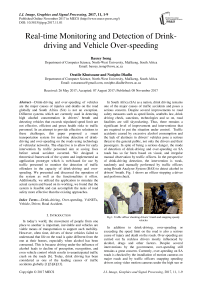Real-time monitoring and detection of drink-driving and vehicle over-speeding
Автор: Bassey Isong, Oratile Khutsoane, Nosipho Dladlu
Журнал: International Journal of Image, Graphics and Signal Processing @ijigsp
Статья в выпуске: 11 vol.9, 2017 года.
Бесплатный доступ
Drink-driving and over-speeding of vehicles are the major causes of injuries and deaths on the road globally and South Africa (SA) is not an exception. Different systems which are currently used in detecting high alcohol concentration in drivers’ breath and detecting vehicles that exceeds stipulated speed limit are not effective, efficient and poses health risks to traffic personnel. In an attempt to provide effective solutions to these challenges, this paper proposed a smart transportation system for real-time detection of drink-driving and over-speeding on the roads using technology of vehicular networks. The objective is to allow for early intervention by traffic personnel aim at saving lives before actual accident occurred. We designed a theoretical framework of the system and implemented an application prototype which is web-based for use by traffic personnel to monitor the detection of traffic offenders in the capacity of drink-driving and over-speeding. We presented and discussed the operation of the system as well as the functionalities it offers. Additionally, we utilized the application to simulate the actual system and based on its working, we found that the system is feasible and can accomplish the tasks of road safety more effective than the existing approaches.
Drink-driving, Over-speeding, VANETs, Vehicle, Driver, Road Accident
Короткий адрес: https://sciup.org/15015910
IDR: 15015910 | DOI: 10.5815/ijigsp.2017.11.01
Текст научной статьи Real-time monitoring and detection of drink-driving and vehicle over-speeding
Published Online November 2017 in MECS
In today’s world, the movement of people from one place to another is important, inevitable and vehicles are viable means of transportation to support such mobility. However, often time, drivers of these vehicles failed to understand that life on the road is quite different from the one at their homes, especially when alcohol has been consumed. This is because driving under the influence of alcohol leads to decline of perception, recognition, and even vehicle control which results to unanticipated traffic crash on the roads [6]. Today, drink driving has been considered as one of the leading causes of traffic accidents globally [1][3][4][13].
In South Africa (SA) as a nation, drink driving remains one of the major causes of traffic accidents and poses a serious concern. Despite several improvements to road safety measures such as speed limits, seatbelts law, drink driving check, sanctions, technologies and so on, road fatalities are still skyrocketing. Thus, there remains a significant level of improvement and interventions that are required to put the situation under control. Traffic accidents caused by excessive alcohol consumption and the lack of alertness in drivers’ vehicles pose a serious threat to the general public, not only the drivers and their passengers. In spite of being a serious danger, the mode of detection of drink-driving and over-speeding on SA roads has so far been based on visual, and irregular manual observation by traffic officers. In the perspective of drink-driving detection, the intervention is weak, randomly and manually performed by traffic officers using Breath Analyzer System (BAS) to detect alcohol in drivers’ breath. Fig. 1 shows an officer stopping a driver and perform check.
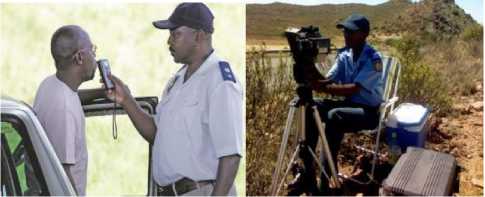
Fig.1. Traffic officer checking drivers’ breath and snapping speedy vehicles
In addition to drink-driving, over-speeding or exceeding the speed limit on the road is also a serious cause of injury and death on the roads. Over-speeding are carried out by reckless drivers mostly influenced by alcohol, drugs and other factors. Despite several interventions by the government, over-speeding still remains a great concern. Currently, over-speeding on SA roads is checked by the installation of motion cameras on major roads and by traffic officers snapping speeding drivers using video motion cameras under the high sun or other adverse whether condition. (See Fig. 1). This paper thus, considered these approaches not effective, not visible, risky and poses health concerns to the officers. Hence, an affective and visible approach is needed to keep drink-driving and over-speeding under check. In other words, accidents leading to injury and death can be reduced if there is a system in place with an effective detection and monitoring mechanism to check drinkdriving and over-speeding in real time.
Over the years, several studies have been performed in the viewpoint of monitoring and detection of drivers. Moreover, many systems have been proposed and developed using different technologies as discussed in [6][7][8][9][10][11]. Some are based on monitoring and preventing drivers’ fatigue while others focus on realtime driving pattern recognition. We considered these approaches workable only in developed countries and not in developing countries. Consequently, existing system are not efficient enough to monitor and detect a driver’s behavior, given their cultural/traditional characteristics. Therefore, this paper proposes a novel system to monitor and detect drink-driving and over-speeding in real-time and provide timely intervention before actual accident occurs. The objective is to reduce high fatality rates and ensure that drivers are in appropriate condition whenever on steering and conscious of safety on the road. The approach employed vehicular ad hoc networks (VANETs) [14] and Internet of Things (IoT) [5],[17] technologies. It involve embedding sensors on every vehicle to detect the alcohol from the driver's breath and over speeding. The information extracted will then be transmitted directly via the Internet in real-time to traffic offices, checkpoint and the cloud-based server to alert of the need to promptly intervene.
The rest of the paper is organized as follows: Section II presents the background study, Section III is the related works, and Section IV present an overview of the proposed system. Additionally, Section V present algorithmic design of the system, Section VI discusses the developed client application prototype while Section VII is the paper conclusion.
-
II. Background Information
This section present background information on drinkdriving and VANETs. We discussed them as follows:
-
A. Drunk-driving and Over-speeding
Alcohol plays an important role in about 80% of peoples’ lifestyles worldwide and is also a significant driving force behind several countries’ economy in terms of jobs creation, fiscal revenues generation [1][2], and so on. However, while its consumption is continuous in an unproblematic or problematic manner, a substantial proportion of its consumption causes great damage to the individuals and the society [1]. According to [1], alcohol consumption is now the third leading cause of injury and death worldwide behind tobacco, high blood pressure, cancer and diabetes.
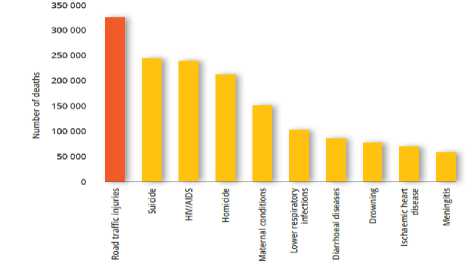
Fig.2. Leading top ten causes of death [3]
On the roads, drink-driving has been identified as the leading cause of death and injury popularly known as traffic accidents [1][3][7][10][11]. Driving under the influence of alcohol has taken a greater proportion in road traffic crashes which is followed by drowsiness, inattention and drunk pedestrians. Other factors include increased stress level, reduced sleep and variation in sleep pattern and time, long distance travel [10]. According to the 2015 WHO Global Status Report on Road Safety [3], globally, road traffic injuries is the leading cause of death and have claimed more than 1.2 million lives each year. (See Fig. 2). Moreover, lack of data on road traffic crashes due to drink- driving has adversely influence the measures to help countries evaluate and provide solutions. Only about 95 nations provides data on part of road traffic deaths originating from alcohol consumption with Costa Rica and Oman recording less than 1% of deaths and as high as 58% in SA [3]. In SA drink-driving which in turn influenced over-speeding is a serious concern and remains one of the major causes of traffic accidents. Statistics shows that road fatalities during festive period alone climbed to 14% and within the periods of 2015 and 2016, a total of 1755 accidents were registered [4].
-
B. VANETs
Vehicular Ad-hoc Networks (VANETs) utilizes efficient technologies that support intelligent transportation systems (ITS) [14]. In recent years, VANETs have received significant attention and was introduced to maximize road or traffic safety, improve drivers awareness and enhance transport efficiency by providing real-time road traffic information as well as and enhance the entertainment system of a vehicle in motion for the comfort of passengers [15]. VANETs currently, is using the Dedicated Short Range Communication technology (DSRC) which is the standard of IEEE 802.11p [14] to improve road safety.
VANETs consist of different communication models and architectures such as vehicle-to-vehicle (V2V) and vehicle-to-infrastructure (V2I) communication [14],[15]. Communication is provided either via road side units (RSUs) or on board units (OBUs) [16]. In VANETs, mobile nodes are embedded with sensors called on-boardunit (OBU) that wirelessly communicate with other nodes on their wireless medium range. (See Fig. 3) The OBU enables vehicles to be able to send, receive and route packets to and from other vehicle nodes as well as the
RSU. On the other hand, RSUs are fixed nodes which are connected to the backbone of the network, the Internet to facilitate communication (i.e. send, receive and route packets). They are placed strategically on the roads and to enable flow of effective, reliable, and timely vehicular connection with the network. However, the number and distribution depends on the communication protocol employed. VANETs have been widely applied in the areas of road safety, entertainment and so on. In this paper, we employed VANET in the capacity of real-time monitoring of drink-driving and over-speeding.
3G/4G/5G
RSU
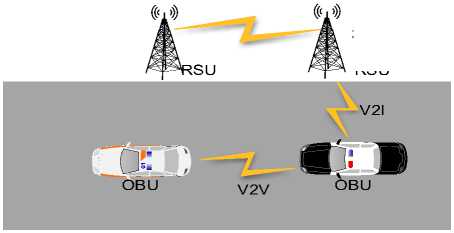
Fig.3. VANETs communication architecture
-
III. Related Studies
Several works have been carried out in the effort to enhance the challenges faced on roads in terms of drinkdriving and over-speeding. In one of these studies, Dai et al. [6] proposed a system to detect and alert dangerous driving triggered by drunk-driving in real-time using mobile phone. It requires placing a mobile phone alongside accelerometer and orientation sensor in a vehicle. With the phone, the accelerations can be read and compared with the pattern behaviour of drunk-driving. Once the pattern is detected, the mobile will automatically alert the driver or even call the police before accident occurs. In a similar work, Aravind et al. [7] proposed a novel technique called E-Eyanthra to prevent drunk-driving. It uses infrared (IR) wave analysis to detect ethanol from the driver’s sweat using IR sensors. The sensors are mounted on the steering which detects the presence of ethanol and sends alert to nearest police control tower alongside the location, and vehicle registration number. Murata et al. [8] also proposed a system to detect alcohol or biological condition on the driver’s body and issue warnings whenever abnormal behaviour is suspected. It uses a car seat containing the air-pack sensor which apply frequency time series analysis to detect between normal and intoxicated state of a person. Moreover, Sakairi et al. [9] also proposed an approach called water-cluster-detecting (WCD) breath sensor for detecting alcohol in breath as well as drowsiness. The approach employs both WCD breath sensor together with alcohol sensor detects using an electric field to detect the electrical signals of both breath and alcohol.
Ramesh et al. [10], proposed an approach based on intelligent wireless sensors network to monitor and detect in a real-time, the drowsiness of drivers to prevent or reduce accident rates. It uses multiple non-obstructive sensors which continuously monitor the driver’s physiological patterns and activates the first alarm to the driver and the passengers while the second alarm is sent to a nearby police station or the rescue teams together with the identification number and the real-time location of the driver using available wireless ad-hoc network. Dong et al. [11] also proposed a system based on MCU electronic circuit board together with alcohol detection sensor MQ303A to detect driver’s alcohol concentration level. The detected signal is converted to digital signal using ADC0803 handled by MCU. Based on the signal obtained, the car can be controlled automatically and not the driver to avoid drunk-driving accident occurring. Al-Sultan et al. [12] developed a novel and nonintrusive system to detect the abnormal behaviour of a driver using a context-aware system in VANETs. Based on the driver’s behaviour, the system can warn other vehicles on the road to prevent the occurrence of accidents. They proposed a five-layer context-aware architecture and used a probabilistic model based on dynamic Bayesian networks (DBNs) in real time. In addition, Pharnama et al. [13] also proposed a system to detect driver’s awareness when under the influence of alcohol. The approach involved a program installed on smartphones which evaluate driver's awareness via questioning and assessing the driver’s answers with voice recognition before and during driving. Once the percentage of correctness exceed wrong answers, an abnormal awareness is detected and system alert the driver and notify any contact via SMS with the driver’s location.
The above discussed related works focused on different approaches to prevent or reduce drink-driving and overspeeding related accidents on the road. While [11] requires the automatic control of the care if high alcohol is detected on the body, [6],[7] and [10] proposed a system that activate an alarm and alert nearby police. Accordingly, [12] only warn other drivers on the same road to be cautious to avoid accident and [13] alert the driver and any chosen contact using SMS. However, the approach in this paper is based on both monitoring of alcohol concentration and over-speeding in real-time on the roads to avoid accidents occurring by automatically alerting traffic personnel. In addition, it will store data on regular basis for analysis and future decision making using cloud-based server.
-
IV. Proposed System
In this section, we present the proposed system in terms of it architectures and components.
-
A. System Overview
This system is derived from the idea of VANETs [14] and IoTs [5]. The aim is to mitigate road accidents caused by drink-driving and over-speeding on SA roads. Furthermore, it is also aimed at ensuring that traffic officers’ lives are not exposed to health hazards as currently experienced.
Real-Time Drink_Driving and Speed Detection System
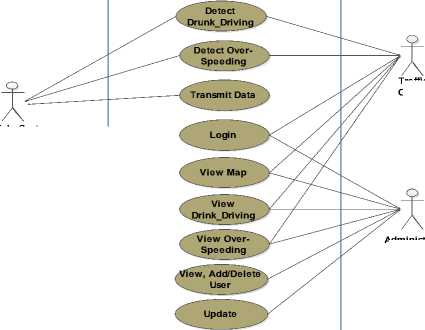
Login
View Map
Update
View Over-
Speeding
Detect Over-
Speeding
Detect nk Driv
View k Drivi ew, Add/Del
User
Vehicle System
Administrator
Fig.4. Proposed system use cases
Traffic
Officer
The system is expected to operate in real-time manner to detect both drink-driving and over-speeding. In particular, the IoT is employed via embedded sensors sensing data of driver’s breath and over-speed inside the drivers’ vehicle and communicate the information using VANETs technologies to traffic officers in real-time. To actualize this, an application is developed that allows traffic officers on duty to view drink-driving and overspeeding offenders in real-time as displayed on the traffic map. With the real-time data, traffic officers can go after the corresponding drivers as an early measure to prevent disasters on the road. In addition, they system employs an administrator who will be responsible for managing the tasks captured in Fig. 4. Requirements for the proposed system were actually elicited using observation where we witnessed series of accidents on the roads which has resulted to serious injuries and deaths as well as the operations of the SA traffic personnel.
-
B. System Architecture
The system architecture communicate visually and theoretically, the framework as well as the interrelationship between the components of the system. This is captured in Fig. 5. The components are the Cloudbased database, Vehicle System, and the Traffic Office/Checkpoint.
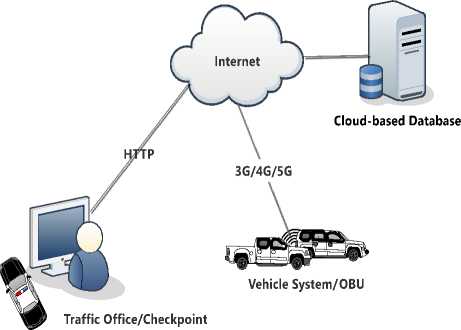
Fig.5. System architecture
The basic elements in the system architecture are discussed as follows:
-
1) Cloud-based database: This is a web entity or a cloud server where data collected by sensors are stored using VANETs connection via the Internet in real-time. It allow data to be shared and accessed at anytime, anywhere and data can be stored for later use. The cloud database will be used to store and retrieve important traffic information either in real-time or later by the traffic officers.
-
2) Traffic office/checkpoint (TOC): TOC acts as the end-points or receiving point of the data collected by the embedded sensors. TOC consist of the traffic officers and the Client Application which is both stand-alone and web-based installed in the PC linked to the system. The application shows data tables which contain details and status of traffic offenders in terms of over-speeding and drink-driving as well as traffic map used to monitor the designated roads in real time .
-
3) Vehicle system: Vehicle system or the OBU comprised of all the hardware components integrated in the vehicle that will assist in the collection of data: speed limit and high alcohol concentration in drivers’ breath, location coordinate (via Global Positioning System (GPS) or a Differential Global Positioning System (DGPS) receiver) and transmit them via 3G/4G/5G network in real-time to the receiving end for onward processing, feedback and necessary action. It also include a displayed unit where feedback sent to drivers as warning can be viewed as well as a controller for data processing.

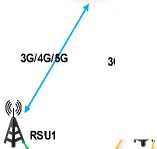
INTERNET
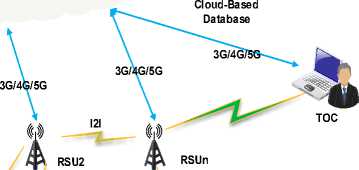


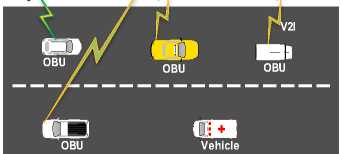
Double Lane Road
Fig.6. Proposed system architecture
-
C. Network Architecture
In order to guarantee effective functioning of the proposed system, we employed VANETs given the involvement of moving vehicles as well as the Internet. In this case, both OBU and RSU will be used to facilitate information sharing between TOC and each vehicle on real-time mode. The OBU is the mobile node acting as a transceiver device installed in each vehicle with other hardware devices to wirelessly receive and process the information then send it on as a message to the RSUs. RSU is the static nodes which will be fixed along the road side. It will wirelessly connect the OBU to the Internet or to another TOC’s Server to get real-time information about traffic activities on the road. (See in Fig. 6). The architecture model is the V2I and the different vehicle speed limits in each road. However, the connectivity between RSUs and OBUs in each vehicle could impacts data routing and their throughput.
As shown in Fig. 6, the VANET architecture operates by maintaining strong connectivity between the OBU and the RSU. The OBU collect the data (such as vehicle ID, location and speed/alcohol) and send or forward to the RSU which then sends to both TOC Checkpoint and cloud-based server via the Internet. The information in the server can also be downloaded in real-time by the TOC on duty. In addition, if warnings or messages are to be issued by the TOC, it is then send through the Internet and then the RSU to the OBU which is then visualized in the display unit in the moving vehicle.
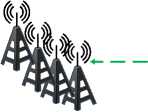
RSU
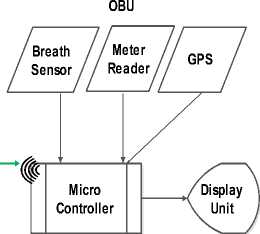
Fig.7. Vehicle system architecture
-
D. Vehicle System Architecture
This section present an in-depth design details of each key component of the vehicle system which is embedded inside a vehicle to help achieve the goal of detection and transmission. This is captured in Fig. 7, which includes the Breathe analyzer sensors, Meter reader, Display unit, Controller and Network access (i.e. OBU). The architecture of the system is referred to as a mobile node.
-
1) Breath analyser sensors: This embedded electronic sensor system is installed on the driver’s side atop the steering. It is an auto-breath analyser which is designed to detect the driver’s breath and forward to the controller.
-
2) Meter reader: This device connects the vehicle’s speedometer to the controller which monitor the speed and read values at regular interval.
-
3) The controller: A central processing system that gets input from the sensors and the meter reader which is also integrated with an access point otherwise OBU. To ensure data is send/receive in real-time, the embedded
system on each vehicle is always active and functioning until a vehicle is switched off.
-
4) Display unit: This is a mini screen or display integrated on each vehicle which is used to automatically display TOC’s messages in the form of warnings whenever high alcohol concentration and speed is detected .
-
5) Access point: This is the OBU, a network device that communicates to and from the RSU in real time.
-
V. Algorithmic Design
In this section, we present the algorithm that describe the operation of the system. It begins with the controller operation and then the overall system operations:
-
A. The Controller Operations
The system will operates by continuously sensing and computing the data received from the sensor and the speed reader. However, not all data sensed will be recorded and transmitted. To this end, data is only recorded if the driver is over-speeding or has exceeded the allowed alcohol level for a driver on SA roads. The process of checking and validating whether data should be recorded is shown in the algorithm represented by a flowchart in Fig. 8.
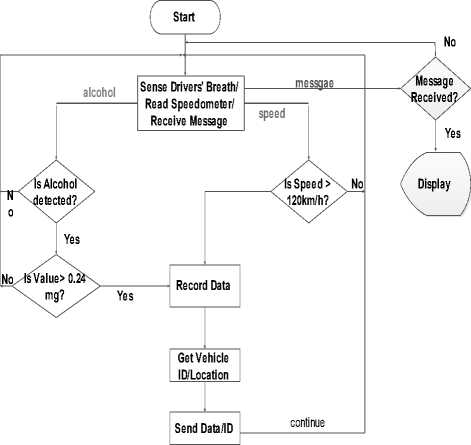
Fig.8. Controller algorithm
Assumptions:
-
• We assumed that this system is deployed in all national roads in SA where the maximum speed is 120 km/h.
-
• We assumed that the legal limit for drink-driving in SA is a breath alcohol content of 0.24 mg per 1,000ml.
-
• We assumed the OBU and RSU are in continuous and active connection.
As shown in Fig. 8, the detections from over-speeding and driver’s breathe is sensed, processed and transmitted to the RSU by the OBU. That is, the sensor will sense breathe and the speed readers will read the speed of the vehicle whether on motion or not. However, recording transmission can only take place if they exceed the allowed limits.
-
B. Overall System Operations
Given the operation of the controller as shown in Fig. 8, once the OBU in each vehicle is in active connection with the RSU on side of the roads, processed-sensed data will be transmitted to the RSU wirelessly which in turn is transmitted to the TOC and to the cloud-based server via the Internet. For ease of identification, each vehicle is identified with an ID which is unique to it. Thus, the data transmitted will include sensed data on alcohol, speed, divers’ ID or vehicle registration number, and the location coordinate. Once the data is sent, the TOC will receive in real-time via the client application installed in the Traffic officers’ computer and traffic monitoring will commence immediately. On the cloud-based database, data can be stored, read, write, and updated. During this period, warning messages will automatically be sent to the corresponding offenders (drivers) twice to alert them and if still ignored after the second message, the vehicle will be booked and traffic officers immediately dispatched to arrest the driver if necessary. A high-level sequence of interaction is shown in Fig. 9.
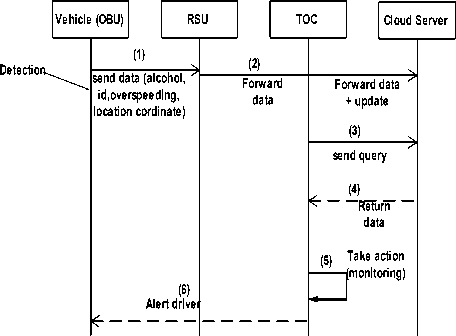
Fig.9. System interaction process
The proposed system will function effectively and with better performance by maintaining a centralized but distributed traffic database in SA having both drivers’ and vehicles’ information. The information to be collected about a driver will include the ID_no, fname, sname, gender, age, phone_no, e-mail and recent address.
For the vehicle, car_type, model, reg_no, engine_no and color will be collected. This database is expected to be in active connection, fast, reliable, robust and able to handle multitude of queries and request in seconds.
-
VI. Application Prototype Implementation
In this section, we present a prototype of the client application to be installed on traffic personnel’s computers for used at the TOC and in traffic offices. The system is simple and straight forward in terms of usability. The client application will display the information received in real time for usage by traffic officers on duty. As discussed earlier, the presentation is in table as well as a map which is used to view and efficiently monitor the traffic in real-time, highlighting vehicles to focus attention on. We developed the web application using Laravel, a PHP language based Framework, due to the availability of several essential packages and security features as well as Model-View-Controller (MVC) pattern. MVC is an architectural pattern for manageable, readable and clean code. The models deals with the data logic and communication to the database while the controller is the middleware which perform create, read, update and delete functions. Additionally, the view component handles all the visual aspects of the application.
-
A. Application Interfaces
This section present the core traffic monitoring interfaces offered by the system. The interfaces offered are user-friendly and simple. To use the application, traffic officers on duty have to first authenticate themselves to gain access by way of login. After logging, the traffic officer will be directed to the traffic main page which shows the table displaying information of offenders’ vehicles in real-time with color highlights showing the severity of the offence. For instance, high alcohol level/percentage and speed limit will be highlighted in red colour. (See Fig. 10) This is important to enable traffic officers take necessary actions against the offending drivers on time. Furthermore, there is also a regular real-time updates of the information about the alcohol concentration and speed about a particular vehicle. On the other hand, an integrated traffic map as shown in Fig. 11 will provide traffic officers with a visual information about the traffic on road, given the location of each vehicle and the severity of the offence. In Fig. 11, the vehicle icon in the map is colored red if the car is an offender. Such icon can further be clicked to view the information of the vehicle and track it accordingly.
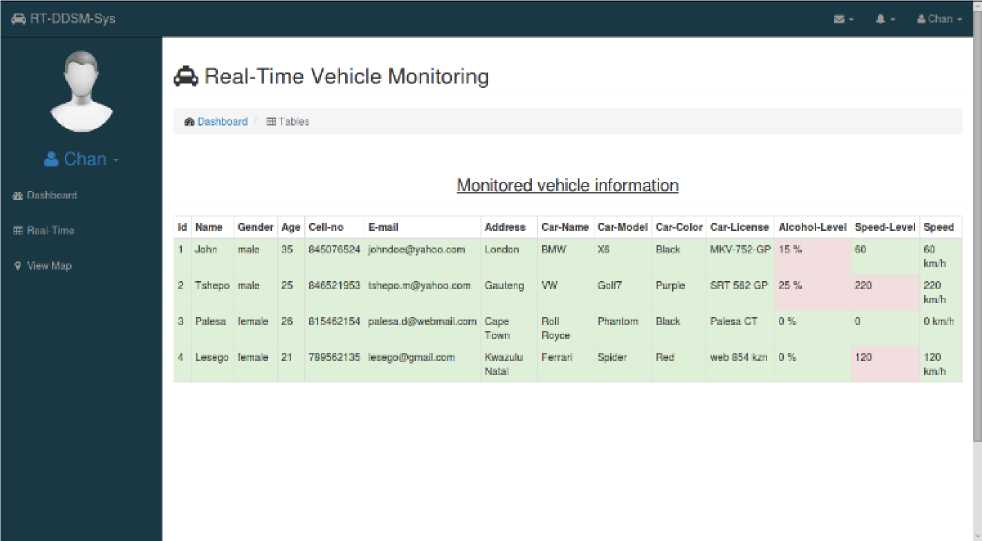
Fig.10. Traffic view page
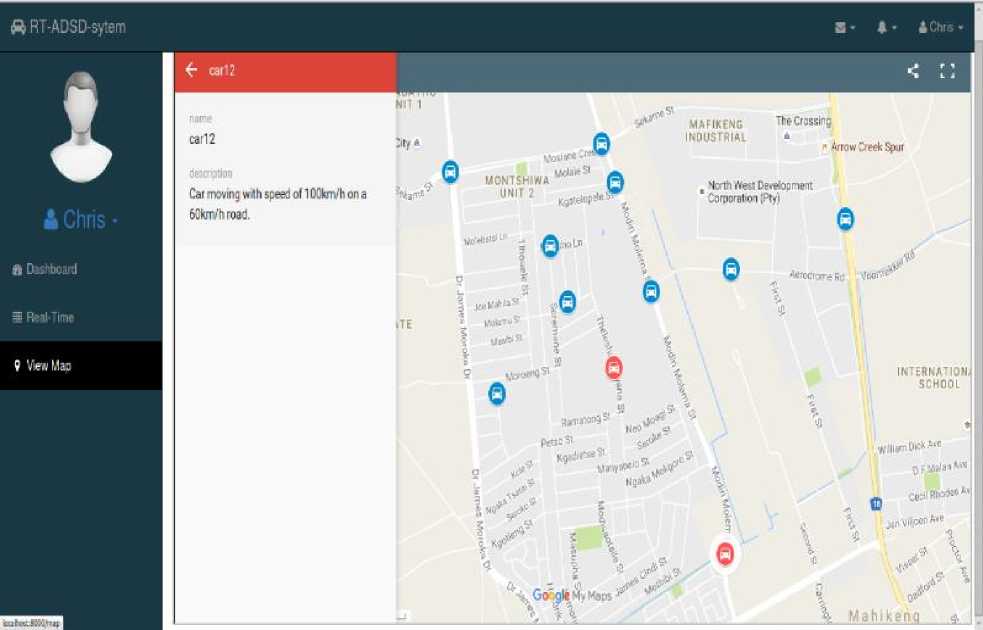
Fig.11. Real-time traffic map
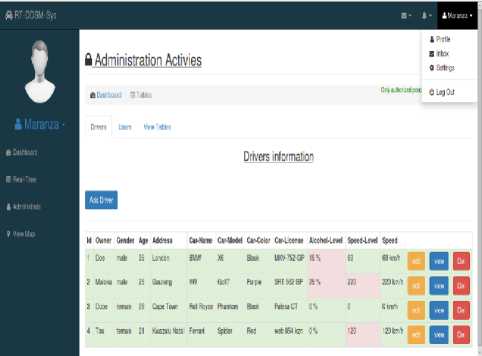
Fig.12. Traffic admin page
In the perspective of the system administrator, after login, he/she will be directed to an administrative page which is equipped with more privileges and functionalities to perform the tasks of manage information, creating, reading, updating and deleting drivers and users in the system. This is shown in Fig. 12 while Fig. 13 shows the driver’s profile information.
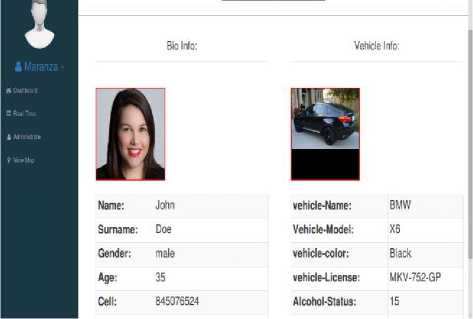
Fig. 13 Driver’s profile
-
B. Theoretical System Evaluation
This section present a theoretical evaluation of the proposed system based on simple simulation we performed as shown in Fig. 10 and 11. Given the system’s operation, we carried out the evaluation using the following criteria:
-
1) Efficiency: The system offers effectiveness in traffic monitoring and detection of drink-driving and over-speeding compared to the manual way used currently by the traffic officers which is random, irregular and inefficient.
-
2) Response: System response time gives the ability of real-time monitoring of traffic.
-
3) Road Safety: The system promotes road safety and its measures by being able to save lives on the road through prompt detection.
-
4) Automation: The system is able to monitor and detect drink-driving and over-speed automatically
without human intervention. This in turn saves traffic officers from the health risks of working under adverse whether conditions as well as saving them from being in contact with contiguous or airborn disease such tuberculosis and so on .
-
VII. Conclusions
In recent years, we have witnessed great technological innovations and inventions in our e-societies which have impacted lives substantially and is still continuing. However, our roads are not left out. Thus, in this paper we proposed an approach to monitor drink-driving and over-speed on SA’s roads automatically without having to deploy traffic personnel. We employed the technologies of IoT, VANETs and even cloud computing to bring innovation in to the transportation sector. In this paper, we presented a theoretical-design framework and provide explanation of the different components as well as their operations. The benefits attributed to such system if adopted for implementation include:
-
• Instead of traffic officers risking their health and lives to be at the road side monitoring traffic offenders, this system automatically does it with no or little human intervention.
-
• It will allow traffic officers to be in multiples sites at the same time and still function effectively. Thus, it enhance the performance and efficiency of traffic officers in monitoring traffic.
-
• It will also serve as data generator for traffic statistics for research in improving traffic monitoring strategies in the future.
Despite the benefits, the proposed system is without limitations. This paper only provided a theoretical design and the complete implementation is lacking due to financial constraints in terms of resources like sensors and VANETs infrastructures. However, the assessment performed so far on the developed prototype yielded a promising response of the system, the ability for real-time to detect drink-driving and monitor over-speeding. It is on this note we conclude that real-time drink-driving and over-speeding monitoring system is necessary for road safety on SA roads and also to provide efficiency in terms of traffic monitoring to save lives. Moreover, as part of the future work, we intend to gather needed resources to implement the complete system for trial on real-world road in SA as well as to optimizing the solution.
Список литературы Real-time monitoring and detection of drink-driving and vehicle over-speeding
- European Transport Safety Council. Drinking and driving in commercial transport. Brussels:ETSC;2012(http://etsc.eu/wpcontent/uEndEjhploads/Drink_Driving_in_Commercial_ Transport.pdf, accessed 15 January, 2017).
- Anderson, P. & Baumberg, B. Alcohol in Europe: A public health perspective, report prepared for the European Commission, Institute for Alcohol Studies, London, 2006.
- “WHOGlobalStatusReport2015”http://www.sadd.org.za/education/statistics?showall=&start=2. Date Accessed: 22/08/16
- “Statistics” http://www.sadd.org.za/education/statistics?showall=&start=1 Date Accessed: 22/08/16
- Gubbi, Jayavardhana, et al. "Internet of Things (IoT): A vision, architectural elements, and future directions." Future Generation Computer Systems 29.7 (2013): 1645-1660.
- J. Dai, J. Teng, X. Bai, Z. Shen and D. Xuan, "Mobile phone based drunk driving detection," 2010 4th International Conference on Pervasive Computing Technologies for Healthcare, Munich, 2010, pp. 1-8, 2010.
- S. Aravind, T. Karthick and U. Sakthivel, "E-Eyanthra Perspiration based drunken driving prevention system," 4th International Conference on New Trends in Information Science and Service Science, Gyeongju, 2010, pp. 270-274.
- K. Murata et al., "Noninvasive Biological Sensor System for Detection of Drunk Driving," in IEEE Transactions on Information Technology in Biomedicine, vol. 15, no. 1, pp. 19-25, Jan. 2011.
- M. Sakairi, "Water-Cluster-Detecting Breath Sensor and Applications in Cars for Detecting Drunk or Drowsy Driving," in IEEE Sensors Journal, vol. 12, no. 5, pp. 1078-1083, May 2012.
- M. V. Ramesh, A. K. Nair and A. T. Kunnathu, "Real-Time Automated Multiplexed Sensor System for Driver Drowsiness Detection," 2011 7th International Conference on Wireless Communications, Networking and Mobile Computing, Wuhan, 2011, pp. 1-4.
- W. Dong, C. Q. Cheng, L. Kai and F. Bao-hua, "The automatic control system of anti drunk-driving," 2011 International Conference on Electronics, Communications and Control (ICECC), Ningbo, 2011, pp. 523-526.
- S. Al-Sultan, A. H. Al-Bayatti and H. Zedan, "Context-Aware Driver Behavior Detection System in Intelligent Transportation Systems," in IEEE Transactions on Vehicular Technology, vol. 62, no. 9, pp. 4264-4275, Nov. 2013.
- Y. A. Phanama, C. Duthoit and R. F. Sari, "Aware-D: Voice recognition-based driving awareness detection," 2016 22nd Asia-Pacific Conference on Communications (APCC), Yogyakarta, 2016, pp. 90-95.
- K S. Xu, P. Guo, B. Xu, and H. Zhou, "QoS evaluation of VANET routing protocols," Journal of Networks, vol. 8, pp. 132-139, 2013
- S. Rene, C. Ganan, J. Caubet Fernández, J. J. Alins Delgado, J. Mata Diaz, and J. L. Muñoz Tapia, "Analysis of video streaming performance in vehicular networks," 2011.
- S. Singh, P. Kumari, and S. Agrawal, "Comparative Analysis of Various Routing Protocols in VANET," in Advanced Computing & Communication Technologies (ACCT), 2015 Fifth International Conference on, 2015, pp. 315-319.
- Botta, Alessio, et al. "Integration of cloud computing and internet of things: a survey.” Future Generation Computer Systems 56 (2016): 684-700.

